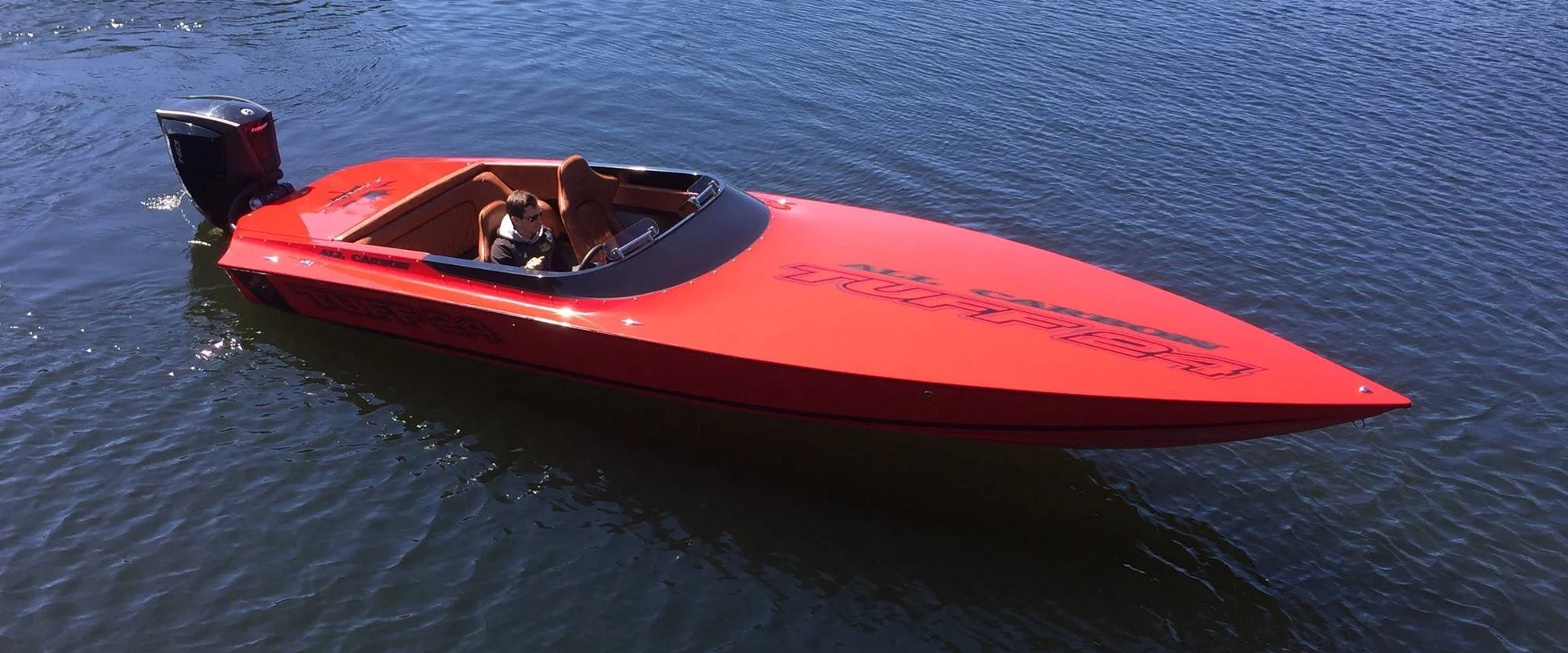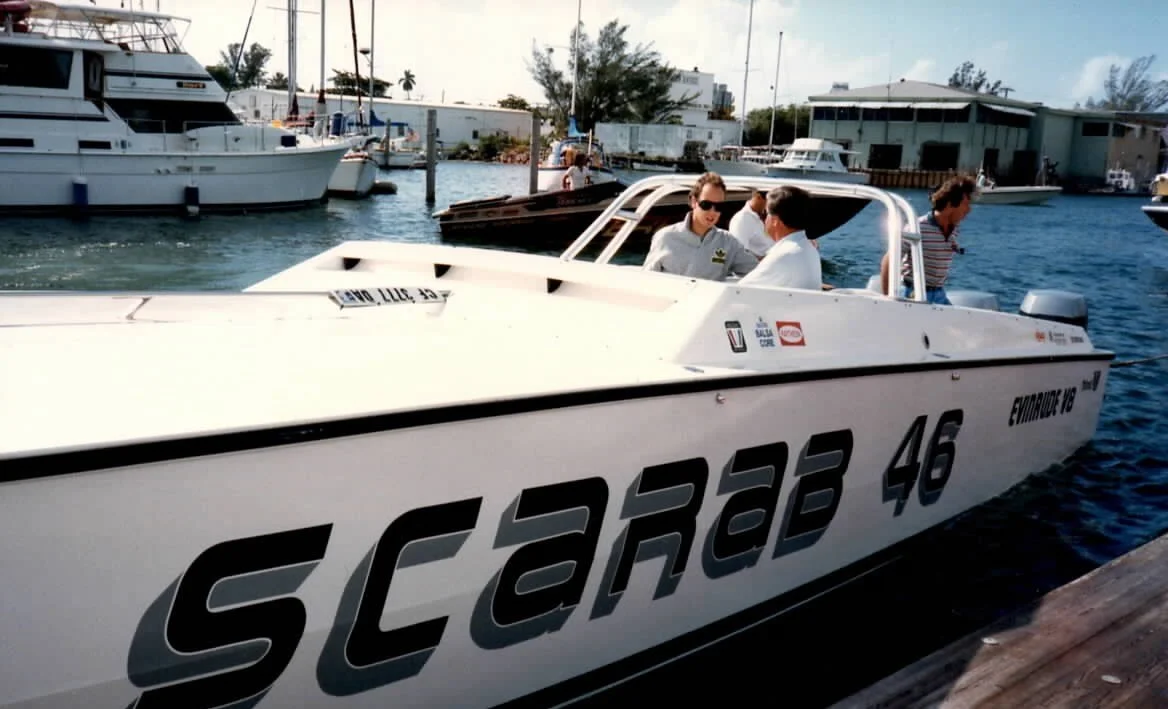10 Questions With Darris Allison
In the performance boat world there are many brands and builders that have come and gone but if you were to pick one boat company that has continuously pushed the envelope in design and performance, it is Allison Boats. There is no other boat company quite like Allison Boats when it comes to innovation, racing, speed records, and longevity. This is part of our 10 Questions series, but this interview ended up being even more, with an in-depth conversation about Darris Allison’s past, the present, and what the future might hold for Allison.
Allison Boats has been using cutting edge materials like composites and wood free construction well before it became mainstream. The Allison Grand Sport is one of their longest running models and not only is the hull still one of the fastest around, it was one of the originators of “rot free” construction back in the 80s. Other innovations include PVC core construction, aluminum reinforced transom, a unique stringer and floor system, creating a “unibody” type of structure. Beyond hull designs, Paul Allison was a pioneer who made the first hydraulic trim, foot throttle, and accidentally designed the cupped propeller innovation back in the 50s, by scraping the prop on the concrete at the ramp. The cupped propeller is an innovation that is one of the most critical to modern boats of all kinds, and the most important to the marine industry according to Darris, and I agree.
One of the reasons Allison has been a leader for over sixty years is their commitment to quality and design but also because of the guidance of Darris Allison, who runs the Louisville based company. Darris got his start early, literally as a child, being involved in racing with his Dad. When the family relocated to Florida, Darris was 10 years old, and ended up being a janitor at a boat factory. Like his father, he was incredibly industrious, and had great skill in carpentry, building his own tree houses, and wiring them with his electrical knowledge. During the discussion, Darris mentioned how his father Paul was so meticulous that he would align all the screws on the boats perfectly. Paul was also the first inductee into the county sports hall of fame, being the first that wasn’t a stick and ball (sports) candidate.
Paul Allison
An early Allison race boat, wood, flat bottom design.
Darris started his own boat company, separate from his father's, when he was just fourteen years old. Paul focused on race boats, while Darris turned more to fishing boats, and revolutionized the bass boat as we know it.
Allison Boats has been around for over 63 years, and in that time has inspired so many other boat designers and builders. Darris remembered a story about Reggie Fountain, “Reggie, after he quit racing, he was a tunnel boat racer for Mercury, and he had an Allison GT 20. He had written a letter saying how much he loved his boat. That kind of inspired him to build his boat, the Fountain. Later, in 2004, him and Ben Robertson set the fastest V hull kilo record at 171 MPH. (That record was held for 10 years.)
I wanted to ask Darris more about building Allison Boats, his favorite designs, and what is next. It was an honor to speak to him, and have him share his stories. We really appreciated his time, here is the conversation.
Q: Who are you and how did you get involved with boats?
A: I got involved immediately, I did carpentry, I did electrical work when I was 8 years old. I built tree houses when I was in the 3rd grade. In 1955, my dad built a little step bottom wood boat, and I remember installing about a thousand slotted brass screws, and that was the beginning of Allison Boats.
I do remember being taken to a boat race when I was about 6 or 8 months. They took the back seat out of the car and set it on the river bank as a seat; I do remember that. Going back to how I got involved, Dad liked to boat race, and friends would get together and race. Dad had an aluminum Alumacraft 14’. He was a body man, so he turned that boat over and polished and buffed it so it looked like chrome. They had rivets, that protruded from the surface, but he polished the bottom to reduce drag. Right here in Louisville, they ran about a mile from the plant.
We moved to Daytona Beach when I was 10 years old. While we were there he worked for a boat company in Port Orange Florida. I rode my bike to school, across the causeway, and the boat plant was on the way. That was my first official job, being employed by someone other than my dad, as a janitor. I was 10 years old. After school I would stop there and sweep and clean up. I made about 25 cents an hour. At that point my dad had that 40 Scott Atwater in about 1957 on his boat, and he had it running 57 MPH. Dad would enter the 100 marathon race in his class and an unlimited class, where guys were running bigger engines from the higher classes. He would sometimes race bigger boats with twin 60 HP engines. Dad would win with his smaller 40 HP.
When I was fourteen years old, I started a totally separate business. I filed taxes as a company when I was fifteen. It was called Allison Craft Boats #2, in the old days so many companies used craft in the name. Later when we incorporated we dropped the craft and it became just Allison Boats Inc.
When we had our anniversary in 2015, we had boats from every decade, except the 50s, they were all wood boats. Dad had his little boat running so well in the 50s, he was beating everybody, and other people wanted him to build boats. So, he was in the autobody business, and building boats as a hobby, but said, “I have to build boats.” Back then, over 50 boats would show up to race. That started the Outboard Powerboat Association. Dad started out building the world’s fastest pleasure boat. His last wood boat was 1960, the first fiberglass boat was in 1961. The Allison Boats outran everyone so bad, they outlawed the wood boats. Well, he just picked up where the wood boats left off and still kept winning with the fiberglass ones.
Q: When designing a hull like the Super Sport, what was the philosophy and what differentiates the hull design from the Grand Sport?
A:The predecessor of both of those boats was the SS 20 and GT 20, and the boat was big and somewhat aerodynamic but it had too much lift in the front. So I decided to build a lower profile faster boat. I came out with the XR 2002 as a lower profile more streamline boat. That’s the boat that set the outboard speed record at 129 MPH, in the 1980s. With a 2.4 Mercury, carburetor engine, it ran a 134 MPH in one pass, but the two way average was 129 MPH. Moving ahead of that, I decided to build a boat more similar to the GT 20. We were building pleasure boats. The bigger version was the Grand Sport. The XR 2002 was smaller. The Super Sport was similar, maybe not as fast as the XR 2002, but is faster than the Grand Sport. The XR 2003, the XB 2003 and the Grand Sport all have the same bottom, not the same mold but the same running surface. They have a 10.5 inch pad, and different setbacks. With the Super Sport we made it with a deeper V and a narrower pad. It would accelerate quicker, it had more frontal area than the XR 2002, so it wouldn't run the same speeds.
The Super Sport has a 22 degree deadrise. Most of our current bass boats have a 23 degree deadrise at the each side of the pad; it progresses to the front. An earlier version of the Super Sport had a 24 degree deadrise that was extremely fast but never would settle on the pad. I generally test the first one out of the mold before I even do a deck for it.
We tested the Super Sport with a 90 HP Honda when it debuted and it ran 70 MPH, but the issue with that engine was it was heavy and sluggish.
An Allison XR race boat. The hull is defined by its pad bottom, balance, design and ability to fly.
Q: What were a couple of the biggest breakthroughs that helped Allison build better boats?
A: The single most revolutionary thing in boating is the cupped propeller. If you took it away, it would destroy the boating industry. You can’t even get on plane with a prop with no cup in it. It would reduce the speed 10 to 20 MPH, you would have to run the motor extremely deep to prevent it from cavitating. My dad accidentally damaged his prop, dragging it over the concrete, and cupped the prop. He started raising the engine up using blocks, reducing the drag. Later, at an event here in Louisville, he outran somebody that had previously outran him, and they asked what he did to that motor, and he said he did nothing, and that his prop was damaged. After fixing it, it reduced the speed, and that’s when he realized it was the curve at the trailing edge.
The second most important was the V bottom pad boat. Back in the 60s, they came out with a V bottom, it rode good, but it didn’t run very fast. Dad, using a board or “ski” design to make a pad on a v-hull revolutionized hull designs.
Q: Your father Paul, and Allison Boats in general have had several innovations and unique designs, can you talk about some of them?
The market we created was, what I would term, the “modern bass boat.” Ours were a deep V hull with a pad. Back then, people didn't want a deep V bass boat, everyone wanted a tri-hull. I was very reluctant to do it, but we built a tri-hull boat, I refused to build a typical tri-hull, so I built a pad bottom boat with a tri-hull front, and it was one of the most popular design. It was the most copied boat, we had over 100 companies on a list that copied our design.
My Dad, came up with a hydraulic jack, where he could pump the handle for a better trim system. They had a squeeze throttle, where it would stay there, wide open, you had to press the button to release it. One hand on the wheel, then he’s got to pump that pump, he’d open up the throttle, then use the pump. He told me during the buoy race, he’d pump that pump out and just outrun everybody. He’d than release the pressure on the pump, to reduce the trim for the turn. In order to keep up with the throttle in the boat, he came up with the foot throttle he designed off an old hinge. But, the cable didn’t have enough tension, so he took the spring from a screen door on the house. And now he had a boat with power trim and foot throttle before anyone.
Going back, in 1969 I had a 66 Corvette. My Dad wanted me to redesign the boat. So, I took the front fenders off of my Corvette and turned them backwards and streamlined them, to create the rear deck lines of all the new boats. All the 13’, 14’ and 18’ foot boats had the Corvette front fender design as the rear sides of the boat. Prior to that, dad had a 1960 Buick that inspired the 1962 model Allison Boat, torpedo shape front, that pointed front. That is in almost all Allison Boats even now. Dad used the front of the hood for the plug.
Allison Boats are race boats, pleasure and fishing boats, but all are based on the most efficient design possible. Darris has always designed for efficiency.
Q: What is your favorite Allison Boat?
The XB 21 ProSport. It's what I call the first "sport utility boat." You can use it for fishing, family boating, skiing, it does everything. It is a really fast boat too.
Q: What are your favorite non Allison boats of all time and why?
The Switzer Craft “Switzer Wing.” It was a catamaran with two cockpits. They were fast, but kind of big and heavy, and raced with twin engines.
As far as styling, the Glastron Carlson, the Art Carlson design. He had a pretty exotic looking boat called the Glastron Carlson.
There was a boat called a Powercat. A catamaran boat, a four point, stepped bottom.
Q: What is next for Allison Boats and the boating industry in general?
Bigger boats. Because of the change in engines by all the manufacturers over the years, which are bigger and heavier, many of Allison’s boats, like the Grand Sport and the Super Sport are too small for that much weight, and The new Mercury V6 four stroke would work on our current larger boats, with solid mounts and a sportmaster gearcase. We want to build a bigger boat that will still fit in a garage. We want to design it so the transom is set in from the back of the boat, and using a swing tongue, we can still fit in a small space. It’s going to be bigger and deeper but still less than 8’ wide. And we are going to be building a larger Grand Sport.
What is next, I can’t say when, I can’t give dates, except one thing; It’s going to be the world’s most efficient hull, we already are, but this boat is going to get triple the gas mileage of comparable size boats. Of course, the only way to do that is to make it faster with the same amount of power by reducing the drag.
The marine industry is following in the footsteps of the auto industry in the 70s when the EPA brought in regulations. Where the engines became big displacement, but low power. All they had to do to cut their emissions in half, is put their engine on an Allison Boat. Simply make a more efficient boat. The engines now are too heavy; you don’t have the concrete underneath you to hold all that weight. They’re doing it the easy way out, big displacement to achieve maximum torque, and then dial in the horsepower.
The issue with many new engines is the gear ratio is all wrong, they make a one size fits all, but that’s wrong. They don't understand, you get out of the hole with the prop, not the gears. Do you think the drag racers run a 2:1 ratio? no. The taller ratio runs faster top end, better acceleration, and quicker out of the hole. Now, you need to run too high of a pitched prop because the gears. You really need at least two different ratios to choose from.
A XR 2002 center steer boat, extremely fast and agile. The design followed the GT series boats
Q: Do you recall some of the early events or races that were notable?
A: In 1963 we took 4 boats to the Orange Bowl Regatta in Miami, 3 were in separate classes and we had one class with two boats in it. We took first in all three classes, and came first and second in the other class. That was the year when Karl Keikeifer sat in the sand behind the boat, looking at the boat, and Charlie Strang was his chief engineer, (he was later head engineer at OMC) and Karl looked at the cupped prop and said “what is this?” Strang said “I believe it must make it more efficient.” And Karl said, “if it makes it more efficient, why aren’t we doing this?” That was 10 years since Dad cupped his first propeller in 1953.
Q: How efficient was the best Allison test boat to date?
I tested a Super Sport with a 45 HP Honda outboard that did 52 MPH. We had an engine that was turbo charged, and it ran 140 MPH on a XR 2002.
Ben Robertson Jr. he drove the 17’ XST that became the first single engine V bottom to break a 100 MPH, with a Twister 2X, 2.0 Mercury V6. It was a bass boat hull with a different deck. I believe that was 1976. In 1969, an 18' Allison driven by Leon Jordan Jr., had twin inline Mercury’s that ran about 101 MPH, that was the fist V hull to break 100 MPH, but that was twin engines.
Thank You Darris.
Afterword:
Because of the long conversation style of this particular interview, some edits were made for brevity and consistency.
The Miami Marine Stadium, Orange Bowl Regatta. Allison took first in every race they entered.
Allison Boats designs are made to cut through the air, aerodynamics are vital over 100 MPH.
A 1960 era boat, with Paul at the wheel. Designer, innovator and racer.














